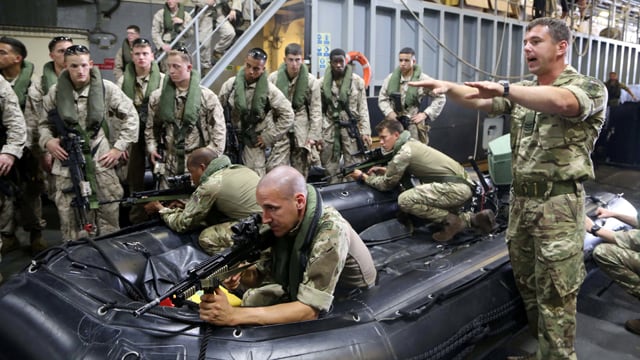Marines will soon head to sea aboard European ships with the Brits, Italians, Spaniards and Dutch.
Starting this fall As early as September, Marines will operate aboard NATO ships as the Corps seeks to fill gaps in sea-basing options in and around Europe. First up will be an Italian ship in September, followed by testing aboard a British gator ship in November as Marines test what's called part of what leaders call the Allied Maritime Basing Initiative.
During testing they'll board Testing will also include Spanish, French and Dutch ships, said according to Brig. Gen. Norm L. Cooling, the deputy commander of U.S. Marine Forces Europe and Africa, although details are still being hashed out.
"They all have ships that could potentially carry an alert force with an Osprey, but the Osprey has unique requirements on deck strength," he said.
The main goal is to devise plans to better hat would offset the Navy and Marine Corps' amphibious ship shortage that Cooling said has limited Marines' ability to quickly respond to crises in mobility of crisis response units Marines responsible for operations in Europe and Africa.
Placing Marines aboard NATO allies' ships will not only allow them to reach flashpoints faster, but will The hope is to posture Marines so they are able to respond more quickly to incidents in Africa, while reassure European partners that the U.S. is NATO allies we are close at hand to counter Russian saber-rattling in Easter Europe.
Testing the international waters
The first Marines to test the concept of putting leathernecks aboard foreign ships will likely be those from the Corps' crisis response unit for Africa. Members of the land-based unit will head to sea during Leaders will station Marines, likely from Special Purpose Marine Air Ground Task Force - Crisis Response - Africa aboard foreign ships before, during and after eExercise Trident Juncture in September2015.
The month-long exercise — hosted by Portugal, Spain and Italy — will be NATO's largest in a decade, with more than 25,000 international troops participating. Trident Juncture is designed to train and test NATO's response forces that would be the first to go to battle if the alliance is threatened.
Marines could deploy aboard anything from a foreign aircraft carrier to an amphibious assault ship capable of high-level operations in and around Europe and Africa, said Capt. Richard Ulsh, a Marine Forces Europe and Africa spokesman. But Cooling said Marines will have to be sure the ships are compatible with the MV-22B Osprey aircraft, which has "unique requirements on deck strength."

A British Royal Marine officer instructs members of the 11th Marine Expeditionary Unit aboard the Royal Navy's auxiliary landing ship dock Lyme Bay during Exercise Cougar Voyage 2015. Marines will be based on allied ships this fall as the service explores ways to cope with amphibious ship shortages.
Photo Credit: Cpl. Demetrius Morgan/Marine Corps
They'll test whether allied ships can handle the weight, heat and pressure the tiltrotor aircraft generates. It will also need to fit in a ship's hangar.
"These initial efforts are focused on our ability to partner with the international crews and learn how to conduct shipboard operations from their vessels," Ulsh said.
Prior to Exercise Trident Juncture the exercise, Marines will conduct landing qualifications aboard the Italian aircraft carrier Cavour, Ulsh said. In November, the same qualifications will be held aboard the British HMS Ocean, the United Kingdom's only amphibious assault ship.
"For these two fall deployments, infantry, aviation and logistics Marines, along with MV-22 Ospreys will embark aboard our allies' ships to conduct combined exercises of Ccrisis Rresponse mission profiles as a limited proof-of-concept of how we could operate with, and from, our allies' ships," Ulsh said.
Corps leaders met June 12 to hash out preliminary details about how many Marines will deploy aboard the foreign ships. Decisions made during that meeting were not available by press time. More will ould be settled during a July planning conference with European allies, Ulsh said.
Alternative sea-basing
Special Purpose Marine Air-Ground Task Force-Crisis Response-Africa will be the unit most likely to participate in the first rounds of the Allied Maritime Basing Initiative.
Stood up in 2013, the 1,700-person force was meant to compensate for the relocation of the 15th Marine Expeditionary Unit to the U.S. Central Command area of operations. The land-based unit is split between Spain, Italy and Romania.
The unit can assemble and deploy to hot spots in Africa quickly, but getting there can be tricky. In January 2014, for example, the Marines were tasked with evacuating State Department personnel from the U.S. Embassy in South Sudan. They flew Ospreys and KC-130J Super Hercules for 16 hours to reach the African country.
Cooling described it as a "significant movement with several stops and aerial refueling."
"Historically we had a MEU aboard an [Amphibious Ready Group] located in the [Mediterranean Sea], but requirements elsewhere globally have taken that resource out of Med where it was readily available for deployment to European and Africa Command," he said.
Basing Marine grunts, aviators and aircraft on an allied ships in the region could decrease those transit times significantly.
"We are looking for alternatives because there is not much amphibious shipping for European Command," Cooling said. "Working with some partner nations, we could put our forces aboard their maritime platforms and it is consistent with NATO interoperability objectives."




